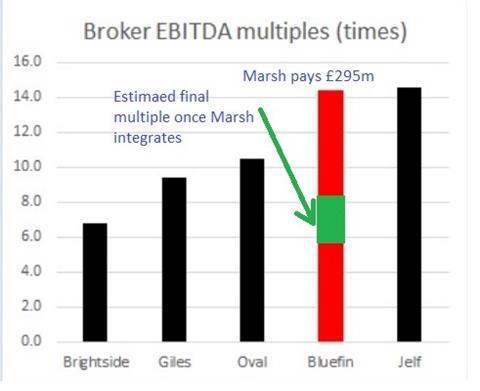Marsh, Aon, Willis appear to pay high multiples for their acquistions targets in the UK. But what is really going on?
By Saxon East
As discussed in the inside story of Gallagher’s Bollington acquisition, an important question concerns how much acquisitions really cost megabrokers over the long term.
When the megabrokers of Aon, Marsh and Gallagher make a major acquisition, it can at first appear they are paying a high multiple of earnings.
Importantly though, the final multiple works out lower once they have taken out costs and integrated the acquisition into their wider business.
So how much exactly lower?
The companies themselves do not discuss details such as multiples.
However, a little bit of work by analysts and market commentators can arrive at reasonable conclusions.
Working through history, here are some of the deals and what analysts/commentators believed at the time would be the final multiple.

In the example above, Marsh paid 14.6x core earnings for Bluefin. However, with cost savings, it was estimated the actual multiple could be as low as between six and eight.
Another example is Hewitt Associates. Aon bought the business for $4.9bn in 2010.
At the time, it was estimated by analysts the multiple of core earnings was x7.5. However, after cost rationalisation and integration, the final multiple was more like x5.
What the final cost actually arrives at depends how aggressively the megabrokers want to save money.
The most aggressive cost-saving measures and synergies can, de facto, save anywhere up to 30% and 40% from the on the nose sale price.
This can appear to offer long-term value to shareholders, especially as the final acquisition multiple is likely to be much lower than the price earnings that Aon, Marsh, Willis trade on.
Risks of cost rationalisation
However, there is a risk.

’The best people will leave’ - ex-JLT chief warns of risks on Marsh takeover
Aon, Willis, Marsh and other megabrokers must handle the cost rationalisation and eventual integration with care.
Otherwise, there is a real risk of staff flight, which would devalue the original purchase.
The trade press are awash with stories of staff moving from brokers. Some employees just don’t like the larger corporate machinery and being subsumed by a bigger entity.
Perhaps this is one of the reasons Gallagher boss Pat Gallagher and Aon chief Greg Case always put such a focus on culture.
Of course, culture helps in dealing with clients and reputation, but the narrative can help morale and crucially, staff retention.
All three brokers fight hard in the war for talent.
All in all, the lesson is clear: you can cut costs, integrate and appear to offer shareholder value in the short term.
But if not done judiciously, it will erode shareholder value.
That’s because you are left with a disgruntled rump of twitchy employees scouring Linkedin for new jobs and whispering to recruitment agents as they gaze at the exit sign.












































No comments yet